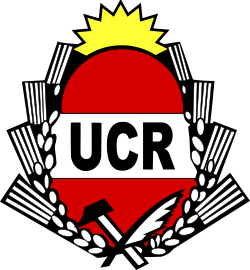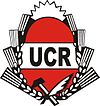- Radical Civic Union
-
Radical Civic Union
Unión Cívica Radical
Leader Ernesto Sanz Founded June 26, 1891 Headquarters Buenos Aires, Argentina Ideology Radicalism,
Social democracy,
Social liberalism,
Progressivism[citation needed]Political position Centre[citation needed] International affiliation Socialist International Official colours Red, White Seats in the Chamber of Deputies
42 / 257Seats in the Senate 14 / 72Province Governors 4 / 24Website http://www.ucr.org.ar/ Politics of Argentina
Political parties
ElectionsThe Radical Civic Union (in Spanish, Unión Cívica Radical, UCR) is a political party in Argentina. The party's positions on issues range from liberal to social democratic. The UCR is a member of the Socialist International. Founded in 1891 by radical liberals, it is the oldest political party active in Argentina. For many years the party was either in opposition to Peronist governments or illegal during military rule.[1]
Contents
History
The party was a spin-off of the Civic Union, which was led by Bartolomé Mitre and Leandro Alem The party unsuccessfully led an attempt to force the early departure of President Miguel Juárez Celman in the Revolution of the Park (Revolución del Parque). Eventually a compromise was reached with Juárez Celman's government. Hard-liners who opposed this agreement founded the current UCR, led by Alem's nephew, the young and charismatic Hipólito Yrigoyen. In 1893 and 1905 the party led unsuccessful revolutions to overthrow the government. With the introduction of free, fair and confidential voting in elections based on universal adult male suffrage in 1912 the Party managed to win the general elections of 1916, when Hipólito Yrigoyen became president. The Radical Civic Union remained in power during the next 14 years: Yrigoyen was succeeded by Marcelo T. de Alvear in 1922 and by himself in 1928. The first coup in Argentina's modern history occurred on September 6, 1930 and ousted an aging Yrigoyen amid an economic crisis resulting from the United States' Great Depression.
From 1930 to 1958 the Radical Civic Union was confined to be the main opposition party, either to the Conservatives and the military during the 1930s and the early 1940s or to the Peronism during the late 1940s - early 1950s. It was only in 1958 when a faction of the party allied with banned peronists (the so called Intransigent Radical Civic Union) came back to power, led by Arturo Frondizi. The growing tolerance of Frondizi towards his peronist allies provoked unrest in the army, which ousted the president in March 1962. After a brief military government, presidential elections took place in 1963 with the Peronist Party banned (as in 1958). The outcome of the elections saw the candidate of the People's Radical Civic Union (the other party's faction) Arturo Illia coming in the first place but with only 25% of the votes (approximately 19% of the votes were blank due to the peronism's banning). Although Argentina experienced during Illia's presidency one of the most successful periods of history in terms of the economic performance, the president was ousted by the army in June 1966. Illia's peaceful and ordered style of governing - sometimes considered too "slow" and "boring" - was being heavily criticized at the time.
During the 1970s Peronist government (1973–1976), the Radical Civic Union was the second most voted party, but this didn't actually grant the party the role of being the political opposition. In fact, the Peronist government's most important criticisms came from the same Peronist Party (now called Justicialist Party). The UCR's leader in those times, Ricardo Balbín, saluted Peron's coffin (Perón had died on July 1, 1974, during his third mandate as president) with the famous sentence "This old adversary salutes a great friend", thus marking the end of the peronist-radical rivalry that had marked the pace of the Argentine political scene until then. The growing fight between left-wing and right-wing Peronists took the country into chaos and many UCR members were targeted by both factions. The subsequent coup in 1976 ended the Peronist experience and "disappeared" many members of the UCR party as well.
Between 1983 and 1989 its leader, Raúl Ricardo Alfonsín, was the first democratically elected president after the military dictatorship headed by generals such as Jorge Videla, Leopoldo Galtieri and Reynaldo Bignone. Alfonsín was succeeded by Carlos Saúl Menem of the Peronist Justicialist Party (PJ).
In 1997 the UCR participated in elections in coalition with Front for a Country in Solidarity (FREPASO), itself an alliance of many smaller parties. This strategy brought Fernando de la Rúa to the presidency in the 1999 elections. During major riots triggered by economic reforms implemented by the UCR government (with the advice of the International Monetary Fund), President de la Rúa resigned and fled the country to prevent further turmoil. After three consecutive acting presidents assumed duties in the following weeks, Eduardo Duhalde of the PJ took office until new elections could be held.
After the 2001 legislative elections it became the second largest party in the federal Chamber of Deputies, winning 71 of 257 seats. It campaigned in an alliance with the smaller, more leftist FREPASO. The party has subsequently declined markedly and its candidate for President in 2003 gained just 2.34% of the vote, beaten by three Peronists and more seriously, by two former radicals, Ricardo López Murphy of Recrear and Elisa Carrió of ARI, who have leached members, support and profile from the UCR. In the 2005 legislative elections, the UCR was reduced to 35 deputies and 13 senators, but remains the second force in Argentine politics.
Current status
Ahead of the 2007 election, the remaining Radicals divided between those who wanted to find an internal candidate and those who wanted to back a candidate from another movement, mostly former Economy Minister Roberto Lavagna, supported by former president Raúl Alfonsín.
In May 2005, the National Committee of the UCR, then led by Ángel Rozas, intervened (suspended of authorities of) the Provincial Committee of the UCR in Tierra del Fuego Province after Radical governor Jorge Colazo spoke in favour of Kirchner's reelection. The intervention was rejected by the Provincial Committee.[2]
A party convention held in Rosario in August 2006 officially rejected the possibility of alliances with Kirchner's faction of Justicialism and granted former Party President Roberto Iglesias the permission to negotiate with other political forces. This led to several months of talks with Lavagna.[3]
The continued dissidence of the Radicales K prompted the intervention of the UCR Provincial Committee of Mendoza on 1 November 2006, due to the public support of President Kirchner by Mendoza's governor, the Radical Julio Cobos. The measure was short-lived, as the Mendoza Province Electoral Justice overturned it three days later. Deputy and UCR National Committee Secretary General Margarita Stolbizer stated that the party is virtually "broken due to the stance of the leaders who support the alliance [with Kirchner]". [4] [5]
Roberto Iglesias eventually resigned the presidency of the party in November 2006 due to differences with Lavagna, having reached the conclusion that an alliance with him would be a mistake, and joined Stolbizer's camp, maintaining that the party should look for its own candidate (the so-called Radicales R).[6] On 1 December 2006 the National Committee appointed Jujuy Province Senator Gerardo Morales as its new president. Morales stated that he wanted to follow the mandate of the Rosario convention (that is, looking for a possible alliance with Roberto Lavagna).[7]
Morales went on to become Lavagna's running mate in the presidential election of October 2007, coming third. Although this campaign represented the mainstream of the national UCR leadership, substantial elements backed other candidates, notably the Radicales K. Cobos was elected Vice President as the running mate of Cristina Fernández de Kirchner through the Plural Consensus alliance, and several Radicals were elected to Congress as part of the Kirchners' Front for Victory faction. The official UCR ranks in Congress were reduced to 30 in the Argentine Chamber of Deputies and 10 in the Argentine Senate.
In recent years the UCR has been riven by an internal dispute between those who support left-wing policies of Peronist President Cristina Fernández de Kirchner and her husband and predecessor Néstor Kirchner. However, most Radicales K support for the Kirchners ended by mid 2008, when Vice President Julio Cobos opposed the Government bill on agricultural export taxes. He later rejoined UCR, becoming a prominent figure in the opposition, despite being still the Vice President.
The UCR joined the Civic and Social Agreement to run for the June 2009 elections. The loose coalition obtained 29% of the national votes and came a close second to the Front for Victory and allies national outcomes. The Party's reorganization, as well as the 2009 elections, resulted in a rebound of the party representatives at the National Congress. By May 2010, its ranks were 42 Deputies and 14 Senators, becoming the first minority party in both houses.[citation needed]
Provincial factions
The UCR has become fragmented politically and geographically. Besides the interventions in Tierra del Fuego and Mendoza, already in September 2006 the party leaders had admitted that they reviewing requests of intervention against the provincial committees of Río Negro and Santiago del Estero.
In Santa Fe, the UCR has teamed up with the Socialist Party to support Socialist candidate for governor Hermes Binner, in exchange for the vice-governorship, taken by the former governor Aldo Tessio's daughter, the fiscal federal Griselda Tessio, winning the 2007 elections.[citation needed]
Leaders of the UCR
The Party is headed by a National Committee; its President is the de facto leader of the party. A national convention brings together representatives of the provincial parties and affiliated organisations such as Franja Morada and Radical Youth, and is itself represented on the National Committee.
- Presidents of the National Committee
- (1891–1896) Leandro N. Alem
- (1896–1897) Bernardo de Irigoyen
- (1897–1930) Hipólito Yrigoyen
- (1930–1942) Marcelo T. de Alvear
- (1942–1946) Gabriel Oddone
- (1946–1948) Eduardo Laurencena
- (1948–1949) Roberto J. Parry
- (1949–1954) Santiago H. del Castillo
- (1954–1957) Arturo Frondizi
- (1971–1981) Ricardo Balbín
- (1981–1983) Carlos Raúl Contín
- (1983–1991) Raúl Ricardo Alfonsín
- (1991–1993) Mario Aníbal Losada
- (1993–1995) Raúl Ricardo Alfonsín
- (1995–1997) Rodolfo Terragno
- (1997–1999) Fernando de la Rúa
- (1999–2001) Raúl Ricardo Alfonsín
- (2001–2005) Ángel Rozas
- (2005–2006) Roberto Iglesias
- (2006–2009) Gerardo Morales
- (2009–2011) Ernesto Sanz
- (2011) Ángel Rozas
- (2011-present) Ernesto Sanz
See also
- List of liberal parties
External links
- Radical Civic Union official site
References
- ^ "Radical Civic Union." Encyclopædia Britannica. 2006. Encyclopædia Britannica Online. 14 Nov. 2006 <http://www.britannica.com/eb/article-9389399>.
- ^ Clarín, 8 May 2005. UCR: Colazo zafó de la intervención.
- ^ La Capital, 27 August 2006. Los radicales se marcharon de Rosario con el corazón partido.
- ^ Clarín, 1 November 2006. La UCR intervino el partido en Mendoza por "desacato".
- ^ Página/12, 5 November 2006. Los radicales K tienen hoy su congreso propio.
- ^ Clarín, 14 November 2006. Se agrandan las divisiones internas en la UCR: renunció el titular del partido.
- ^ Clarín, 1 December 2006. Morales quedó al frente de la UCR y crecen las posibilidades de un acercamiento a Lavagna.

Radical presidents of Argentina Other Radicals Leandro N. Alem • Arturo Jauretche • Ricardo Balbín • Eduardo Angeloz • Rodolfo Terragno • Julio Cobos • Ricardo AlfonsínKey events Revolution of the Park • 1916-1930 period • Trial of the Juntas
Coordinates: 34°36′42″S 58°23′29″W / 34.61167°S 58.39139°WCategories:- Liberal parties
- Political parties in Argentina
- Socialist International
- Social-democrat parties in Argentina
- Social-liberal parties in Argentina
- Political parties established in 1891
- Radical Civic Union
Wikimedia Foundation. 2010.
